Potential of Remote Sensing for the Analysis of Mineralization in Geological Studies
Abstract
1. Introduction
2. Materials and Methods
2.1. Geological Background
2.2. Remote Sensing Data Processing
2.3. Geological Fieldwork
2.4. Geochemical Analysis
2.5. Crósta Method
3. Case Study
3.1. Image Ratios
3.1.1. Ferrous Silicates and Weathering Minerals
3.1.2. Gossans, Lithocap, and All Oxides
3.1.3. Composite Colored Ratios
- Minerals with the AlOH group, advanced clay alteration
- -
- 5/6 ratio for Phengite (Iron- and Magnesium-rich Muscovite)
- -
- 7/6 ratio for Muscovite
- -
- 7/5 ratio for Kaolinite
- Gossan, alterations, and “unaltered” rocks
- Porphyry
- A.
- Advanced argillic alteration: Highlighted by the (4 + 7)/5 ratio, emphasizing clays such as Kaolinite, Dickite, and Pyrophyllite.
- B.
- Phyllic (Chlorite–Sericite) alteration: Identified using the (5 + 7)/6 ratio, revealing Sericite/Muscovite, Illite, and Smectite.
- C.
- Propylitic alteration: Mapped with the (7 + 9)/8 ratio, indicating carbonates, Chlorite, and Epidote.
3.2. Ground-Truth Verification
3.3. Geochemistry Validation
3.4. Principal Components Analysis: Crósta Method
3.5. Uncertainty in Mineral Identification
| Peakk Postion (2θ) | FWHM(β) | Size | Standard Error |
|---|---|---|---|
| 21.07051 | 0.12519 | 64.5208 | 8.21 x 10-4 |
| 26.8499 | 0.12326 | 66.2363 | 1.55 x 10-4 |
| 36.75238 | 0.12628 | 66.2646 | 0.00211 |
| 39.67286 | 0.11439 | 73.8011 | 0.00245 |
| 40.4944 | 0.12246 | 69.1182 | 0.00515 |
| 42.65116 | 0.12782 | 66.6946 | 0.00338 |
| 45.99194 | 0.12997 | 66.3749 | 0.00548 |
| 50.33391 | 0.13436 | 65.3029 | 0.00153 |
| 60.13605 | 0.15929 | 57.6056 | 0.00257 |
| 68.27479 | 0.63134 | 15.1968 | 0.01125 |
3.6. Interpretations
4. Results and Discussion
4.1. Mineralogical Alteration Zones and Their Implications
4.2. Structural Control and Geological Context
4.3. Validation Through Ground Truthing and XRD Analysis
4.4. Comparison with Other Regions and Methodological Value
4.5. Limitations and Future Perspectives
5. Conclusions
Author Contributions
Funding
Data Availability Statement
Conflicts of Interest
Correction Statement
References
- Sabins, F.F. Remote sensing for mineral exploration. Ore Geol. Rev. 1999, 14, 157–183. [Google Scholar] [CrossRef]
- Möller, T.; Williams-Jones, A. Multispectral and hyperspectral remote sensing for mineral exploration. J. Geochem. Explor. 2018, 188, 129–145. [Google Scholar]
- Hewson, R.D.; Cudahy, T.J.; Jones, M.H.; Thomas, M. An integrated approach to mineral exploration using hyperspectral and multispectral remote sensing. Int. J. Remote Sens. 2005, 26, 3333–3350. [Google Scholar]
- Van der Meer, F.D.; de Jong, S.M. Remote sensing and digital image analysis for mineral exploration. Geol. Soc. Lond. Spec. Publ. 2001, 190, 17–33. [Google Scholar]
- Pour, A.B.; Hashim, M.; Hong, J.K. Integration of ASTER and Landsat ETM+ data for the detection of iron mineralization in a tropical region: A case study of Central Eastern Goldfields, Australia. Ore Geol. Rev. 2013, 53, 487–500. [Google Scholar]
- Abrams, M.J.; Kahle, A.B.; Palluconi, F.D.; Schieldge, J.P. Geologic mapping using thermal images. Remote Sens. Environ. 1984, 16, 13–33. [Google Scholar] [CrossRef]
- Rowan, L.C.; Mars, J.C. Lithologic mapping in the Mountain Pass, California area using ASTER data. Remote Sens. Environ. 2003, 84, 350–366. [Google Scholar] [CrossRef]
- Di Tommaso, I.; Rubinstein, N. Hydrothermal alteration mapping using ASTER data in the Infiernillo porphyry deposit, Argentina. Ore Geol. Rev. 2007, 32, 275–290. [Google Scholar] [CrossRef]
- Bedini, E. Mineral mapping in the Kap Simpson complex, central East Greenland, using HyMap and ASTER remote sensing data. Adv. Space Res. 2011, 47, 60–73. [Google Scholar] [CrossRef]
- Abdelsalam, M.G.; Stern, R.J.; Berhane, W.G. Mapping Precambrian structures in the Sahara using multispectral remote sensing: The Neoproterozoic collision zone in eastern Sahara. Tectonophysics 2000, 326, 1–24. [Google Scholar]
- Choukrad, J.; Ait Ali, A.; Si Mhamdi, H.; Ouahzizi, Y.; El Moutaouakkil, N.; Saoud, N.; Charroud, M. Contribution of Landsat 8 OLI imagery to mapping of lithological series and lineaments: Implications for Pb-Zn mineralization exploration in the Boudahar Massif, Eastern High Atlas, Morocco. Estud. Geológicos 2023, 79, e159. [Google Scholar] [CrossRef]
- Elbakhouch, N.; Ibouh, H.; Touil, A.; Chafiki, D. Structural and mineralogical mapping using multispectral satellite data (Aster, Landsat 8 OLI, and Sentinel 2B) combined with field work in the Western High Atlas, Morocco. Geologos 2024, 30, 119–136. [Google Scholar] [CrossRef]
- Michard, A.; Ibouh, H.; Charrière, A. Syncline-topped anticlinal ridges from the High Atlas: A Moroccan conundrum, and inspiring structures from the Syrian Arc, Israel. Terra Nova 2011, 23, 314–323. [Google Scholar] [CrossRef]
- Chabane, A.; El Boukhari, A.; Rocci, G.; Tane, J.L. Découverte d’un magmatisme d’affinité boninitique d’arc associé à l’ophiolite panafricaine de Khzama (Massif du Siroua, Anti-Atlas marocain). Comptes Rendus de l′Académie des Sciences 1991, 313, 1301–1304. [Google Scholar]
- Admou, H. Structuration de la paléo-suture ophiolitique panafricaine de Bou Azzer-Siroua (Anti-Atlas central, Maroc). Ph.D. Thesis, Université Cadi Ayyad, Marrakech, Morocco, 2000. [Google Scholar]
- Huch, K.M. Die panafrikanische Khzama Geosutur im zentralen Anti-Atlas, Marokko. Ph.D. Thesis, Freie University, Berlin, Germany, 1988. [Google Scholar]
- Rehdorf, K. Geologische und geochemische Aspekte von Vorlandgesteinen eines panafrikanischen Subduktionskomplexes nordöstlich des Jbel Sirwa (Anti-Atlas, Südmarokko); Schelzky & Jeep: Berlin, Germany, 1988. [Google Scholar]
- Chevallier, L.P.; Thomas, R.J.; Gresse, P.G.; Macey, P.H.; Martini, E.J.; Harmer, R.E.; Armstrong, R.A.; Eglington, B.M. Geological Map of Morocco at 1:50,000 “Douar Cour Sheet” and Explanatory Note (in French and English); Notes et Mémoires du Service Géologique du Maroc; Ministry of Energy, Mines and Environment: Rabat, Morocco, 2001; 175p. [Google Scholar]
- Choubert, G. Essai de mise au point du problème des “ignimbrites”. Bull. Volcanol. 1963, 25, 123–140. [Google Scholar] [CrossRef]
- Thomas, R.J.; Fekkak, A.; Ennih, N.; Errami, E.; Loughlin, S.C.; Gresse, P.G.; Liégeois, J.P. A new lithostratigraphic framework for the Anti-Atlas orogen, Morocco. J. Afr. Earth Sci. 2004, 39, 217–226. [Google Scholar] [CrossRef]
- Toummite, A.; Ikenne, M.; Beraaouz, E.H. Geothermobarometry of Askaoun Pluton in Ouzellarh-Sirwa Promontory (Central Anti-Atlas; Morocco). Open J. Geol. 2012, 2, 136–147. [Google Scholar] [CrossRef]
- El Arabi, E.H.; Ferrandini, J.; Essamoud, R. Triassic stratigraphy and structural evolution of a rift basin: The Eç Çour basin, High Atlas of Marrakech, Morocco. J. Afr. Earth Sci. 2003, 36, 29–39. [Google Scholar] [CrossRef]
- Crósta, A.P.; Moore, J.M. Enhancement of Landsat TM imagery for residual soil mapping in SW Minas Gerais State, Brazil. In Seventh Thematic Conference on Exploration Geology; Environmental Research Institute of Michigan: Ann Arbor, MI, USA, 1989; pp. 1173–1187. [Google Scholar]
- Ali, S.; Li, H.; Ali, A.; Hassan, J.I. Lithological discrimination of Khyber Range using remote sensing and machine learning algorithms. Appl. Sci. 2024, 14, 5064. [Google Scholar] [CrossRef]
- Velosky, J.C.; Stern, R.J.; Johnson, P.R. Geological control of massive sulfide mineralization in the Neoproterozoic Wadi Bidah shear zone, southwestern Saudi Arabia, inferences from orbital remote sensing and field studies. Precambrian Res. 2003, 123, 235–247. [Google Scholar] [CrossRef]
- Ennih, N.; Liégeois, J.P. The boundaries of the West African craton, with special reference to the basement of the Moroccan metacratonic Anti-Atlas belt. Geol. Soc. Lond. 2008, 297, 1–17. [Google Scholar] [CrossRef]
- Rockwell, B.W. Automated Mapping of Mineral Groups and Green Vegetation from Landsat Thematic Mapper Imagery with an Example from the San Juan Mountains, Colorado: U.S. Geological Survey Scientific Investigations Map 3252; USGS: Reston, VA, USA, 2013. [Google Scholar] [CrossRef]
- Rojas, J.; Fernández, P.; Barrios, M. Characterization of mineral resources using multispectral and hyperspectral imagery. Remote Sens. Appl. Soc. Environ. 2019, 14, 234–245. [Google Scholar]
- Rivas, C.; Delgado, J.; Castillo, L. Hyperspectral mapping in mineral exploration: Techniques and results. Geochem. Explor. 2021, 219, 106773. [Google Scholar]
- Doll, A.; Müller, R.; Stewart, B.; McDonald, J. A comprehensive review of mineral characterization techniques. Minerals 2020, 10, 977. [Google Scholar]
- Davis, G.; Thompson, R.; Evans, M.; Collins, D. Mineralization indicators in volcanic rocks: Case studies and implications. Econ. Geol. 2017, 112, 877–892. [Google Scholar]
- Hedenquist, J.W.; Richards, J.P. The influence of hydrothermal alteration on mineral exploration. Soc. Econ. Geol. Spec. Publ. 1999, 7, 67–83. [Google Scholar]
- Pichavant, M.; Moret, L.; Bastoul, A. Porphyry systems and their mineralization potential. Minerals 2018, 8, 354. [Google Scholar]
- García-Santos, A.; Farias, A.P.; Mendonça, C.A.; Souza, R. Integration of remote sensing and geochemical techniques for mineral exploration. Geochem. Explor. Environ. Anal. 2016, 16, 45–60. [Google Scholar]
- Harris, M.; Smith, J. Satellite imagery for mineral exploration: Methods and applications. Int. J. Appl. Earth Obs. Geoinf. 2020, 88, 102072. [Google Scholar]
- Khalafallah, A.; Omar, F.; Bendaoud, A. Structural geology and mineralization of the High Atlas Mountains. J. Struct. Geol. 2021, 143, 104267. [Google Scholar]
- Lerhris, I.E.; Admou, H.; Alansari, A.; Ibouh, H.; Mouttaqi, A.; Chaib, M.; Admou, S. Mapping and Structural Analysis of Geological Fractures of the Tidili Region, Morocco, Related to South Atlas Fault Zone Using Remote Sensing on Landsat 9 OLI Imagery. Iraqi Geol. J. 2025, 58, 50–72. [Google Scholar] [CrossRef]
- Cottam, M.A.; Atkinson, N.; Collins, A.S.; Cox, J. Tectonic influences on mineralization in the Anti-Atlas Mountains. Geol. Soc. Am. Bull. 2016, 128, 345–357. [Google Scholar]
- Benouar, D.; Mourabit, A.; Abdellatif, M. Geological and geochemical studies in the Ouarzazate region, Morocco. J. Afr. Earth Sci. 2017, 132, 123–135. [Google Scholar]
- Crósta, A.P.; De Souza Filho, C.R.; Azevedo, F.; Brodie, C. Targeting key alteration minerals in epithermal deposits in Patagonia, Argentina, using ASTER imagery and Principal Components analysis. Int. J. Remote Sens. 2003, 24, 4233–4240. [Google Scholar] [CrossRef]
- Inoh, H.; Tayebi, M.; Rajji, A. A comparative analysis of lineaments extracted from Landsat 8 OLI & ASTER-GDEM data, Talmakent Area, Western High Atlas, Morocco. Iraqi Geol. J. 2023, 56, 303–315. [Google Scholar] [CrossRef]
- Scherrer, P. Bestimmung der inneren Struktur und der Größe von Kolloidteilchen mittels Röntgenstrahlen. Nachrichten von der Gesellschaft der Wissenschaften zu Göttingen, Mathematisch-Physikalische Klasse 1918, 1918, 98–100. [Google Scholar]
- Sillitoe, R.H. Porphyry copper systems. Econ. Geol. 2010, 105, 3–41. [Google Scholar] [CrossRef]
- Atif, Y.; Soulaimani, A.; Ait lamqadem, A.; Pour, A.B.; Pradhan, B.; Nouamane, E.A.; Abdelali, K.; Muslim, A.M.; Hossain, M.S. Identifying hydrothermally altered rocks using ASTER satellite imageries in Eastern Anti-Atlas of Morocco: A case study from Imiter silver mine. Int. J. Image Data Fusion 2022, 13, 337–361. [Google Scholar] [CrossRef]
- Camus, F. The Andean Porphyry Systems. In Super Porphyry Copper & Gold Deposits: A Global Perspective; Porter, T.M., Ed.; PGC Publishing: Adelaide, Australia, 2005; Volume 1, pp. 45–63. [Google Scholar]
- O’Connor, J.; Roberts, N.; Cook, G. Applications of XRD in geological studies. Clays Clay Min. 2020, 68, 211–220. [Google Scholar]
- Carrino, T.A.; Crósta, A.P.; Toledo, C.L.B.; Silva, A.M. Hyperspectral remote sensing applied to mineral exploration in southern Peru: A multiple data integration approach in the Chapi Chiara gold prospect. Int. J. Appl. Earth Obs. Geoinf. 2018, 64, 287–300. [Google Scholar] [CrossRef]
- Ramazani, M.; Safari, H.O.; Shamanian, G.H. Integration of ASTER-based remote sensing with petrographic studies, XRD analysis, and field surveying as a multidisciplinary approach for prospecting Cu mineralization in the Taft-Dehshir region, Iran. J. Appl. Remote Sens. 2022, 16, 014508. [Google Scholar] [CrossRef]
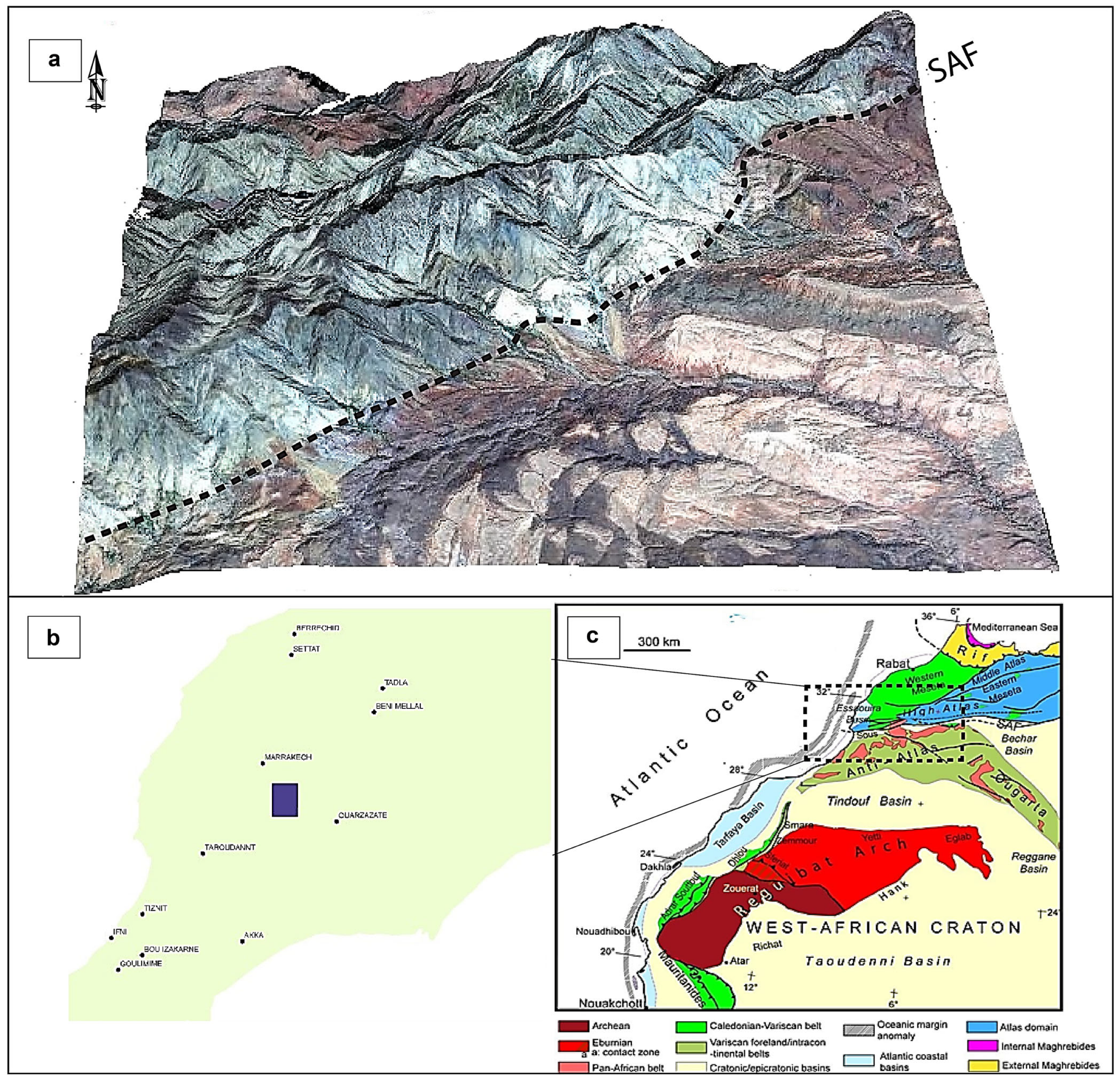
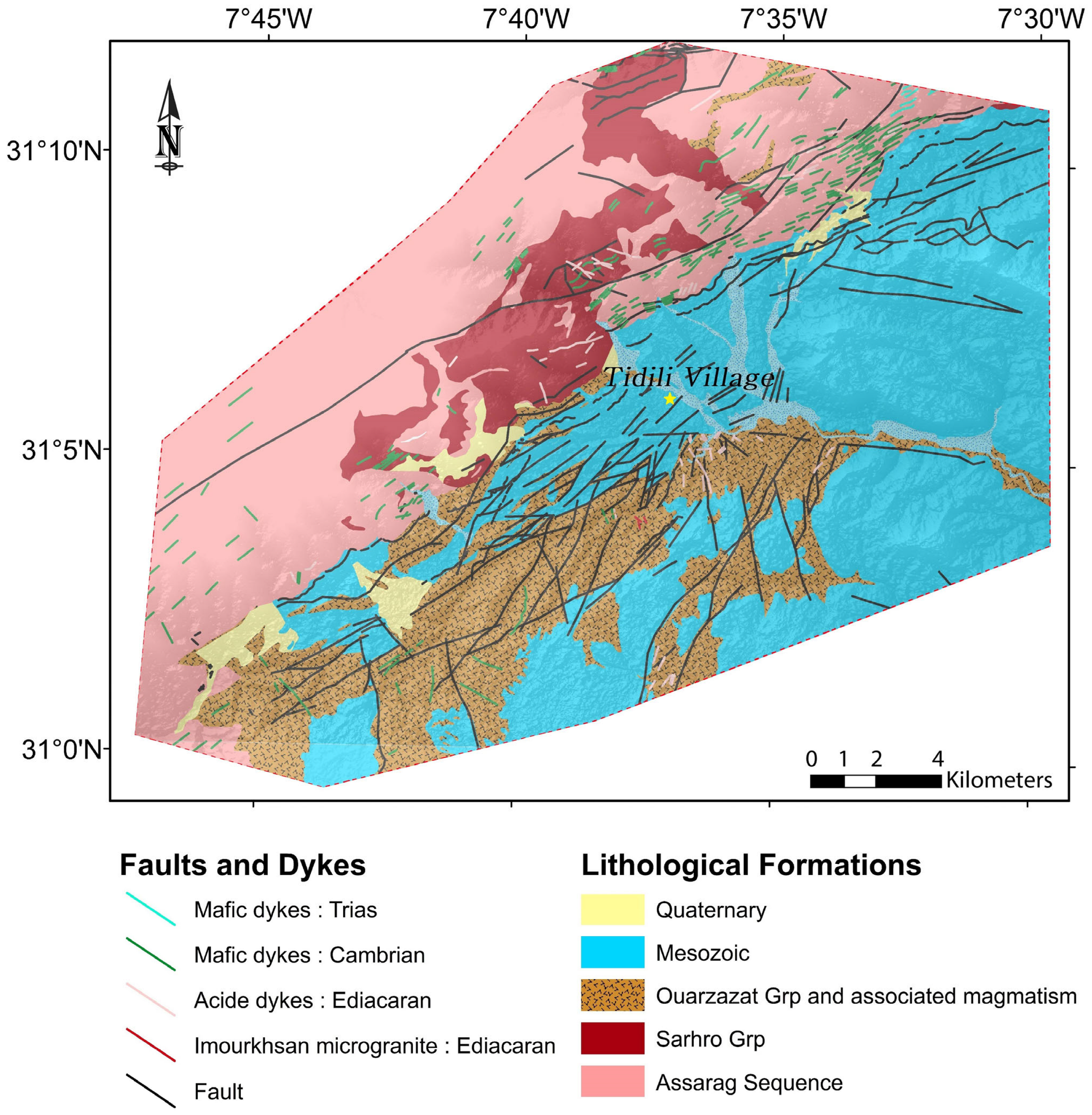
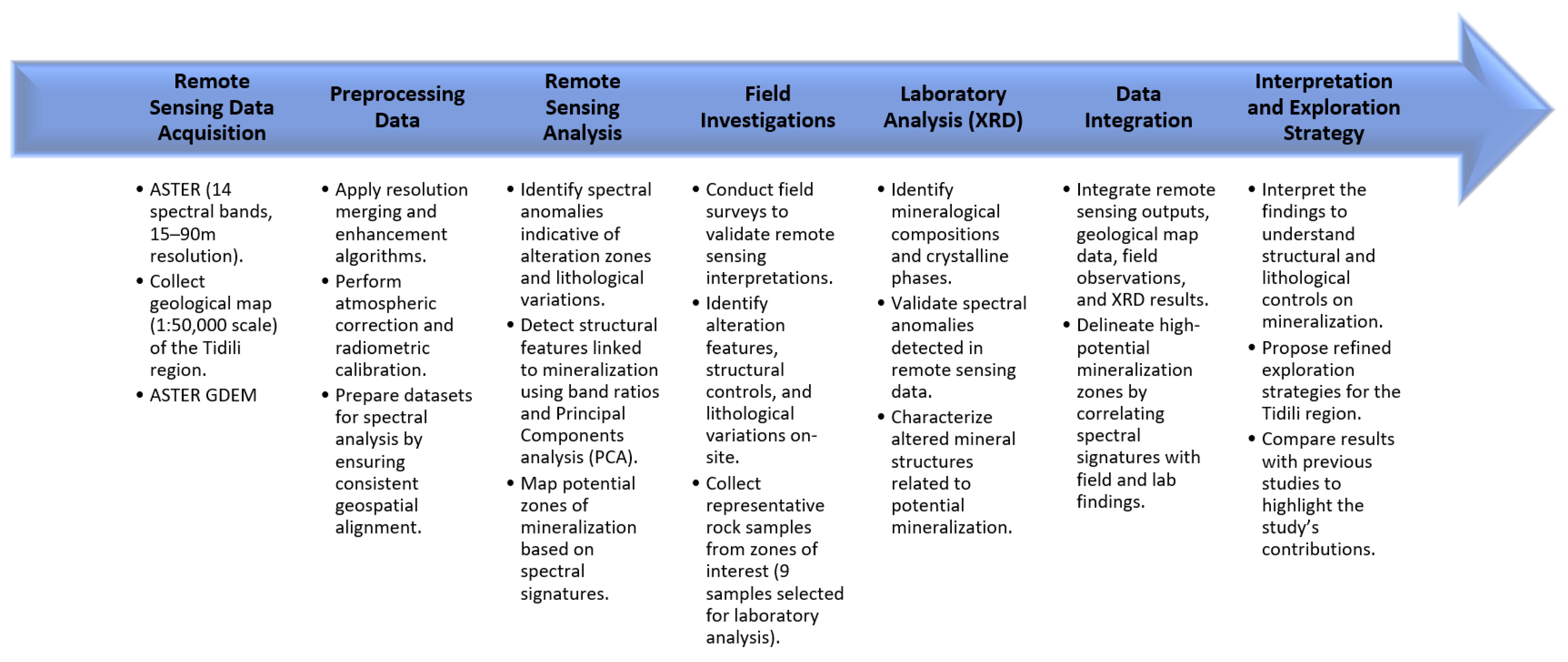

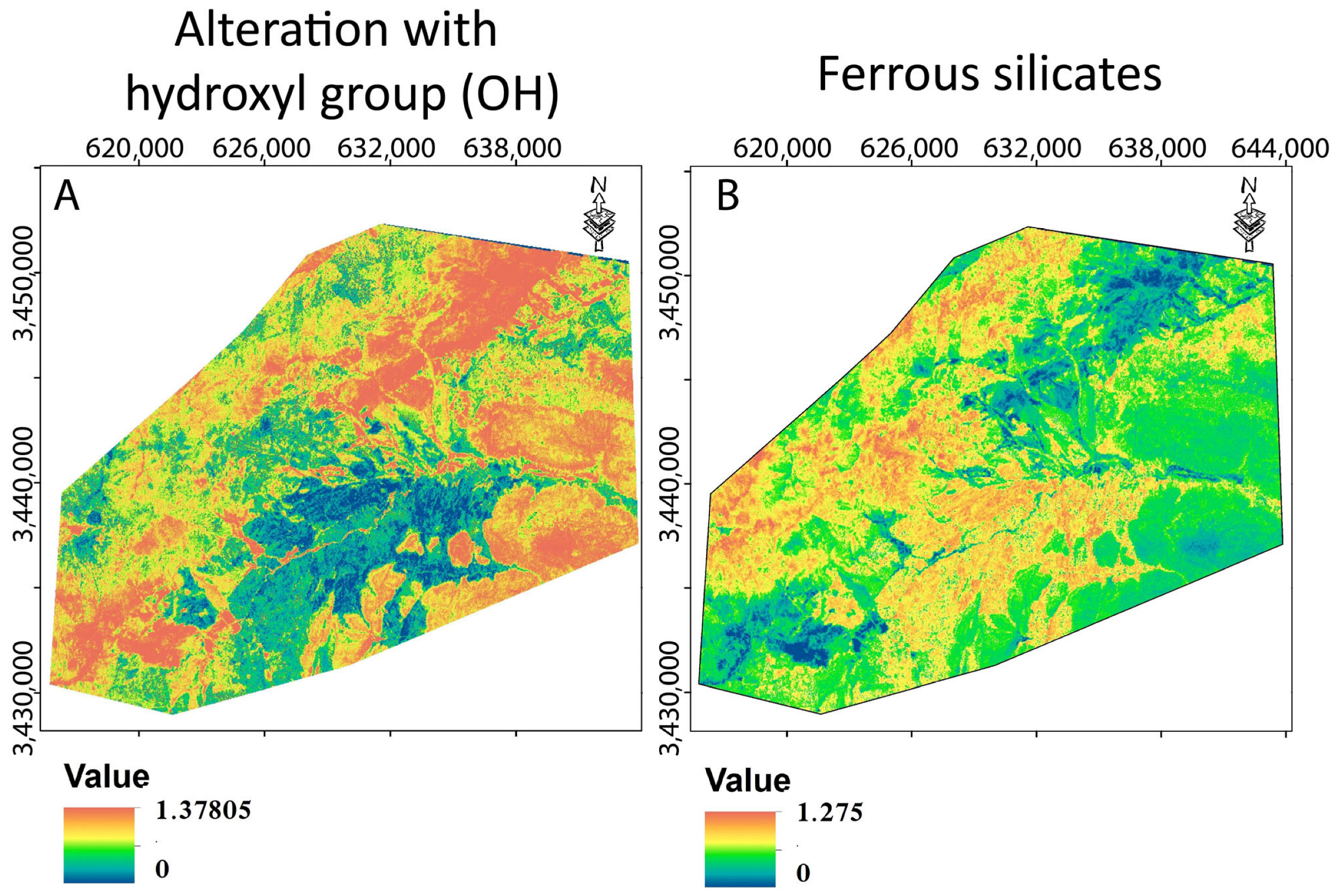

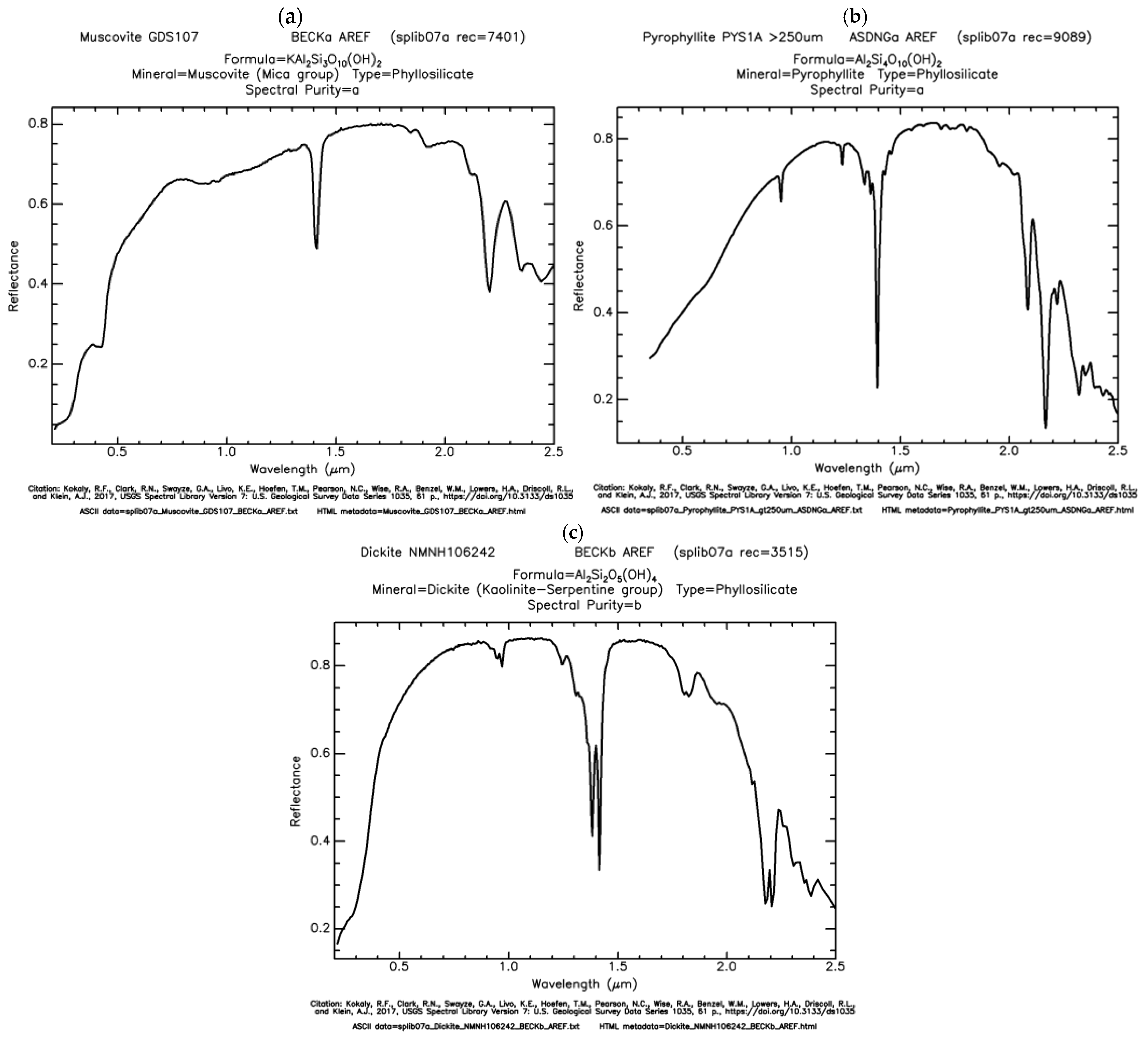
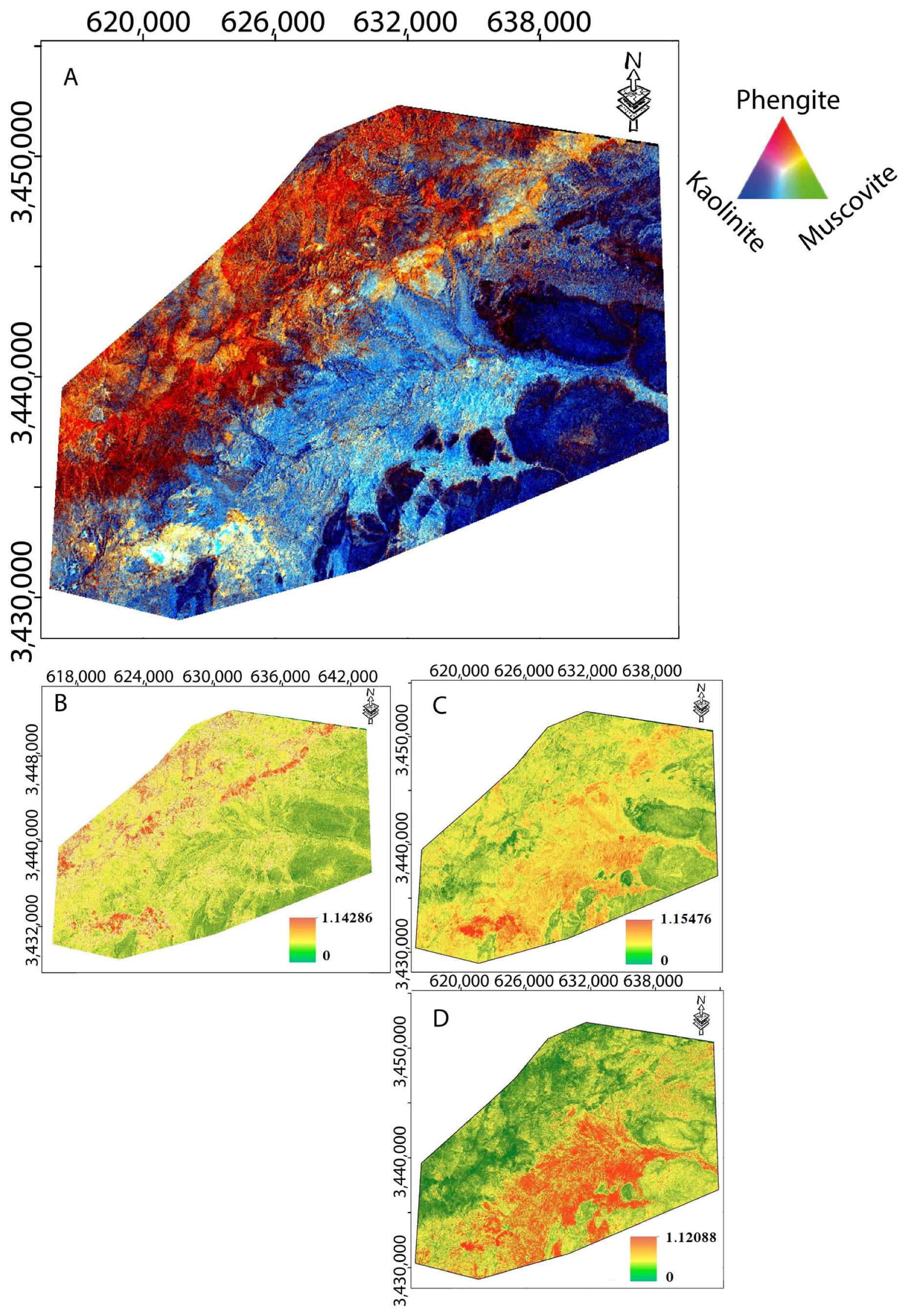
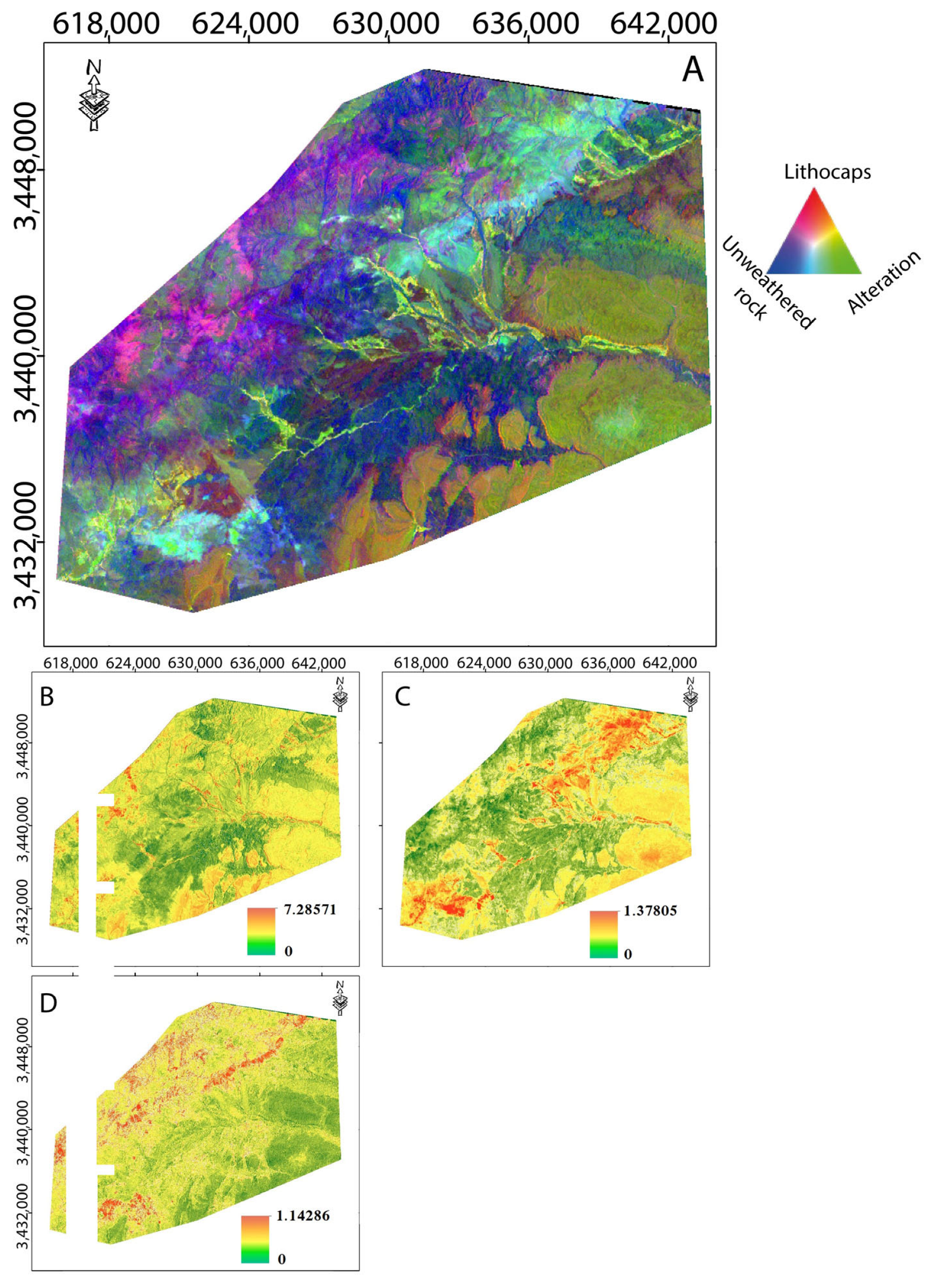
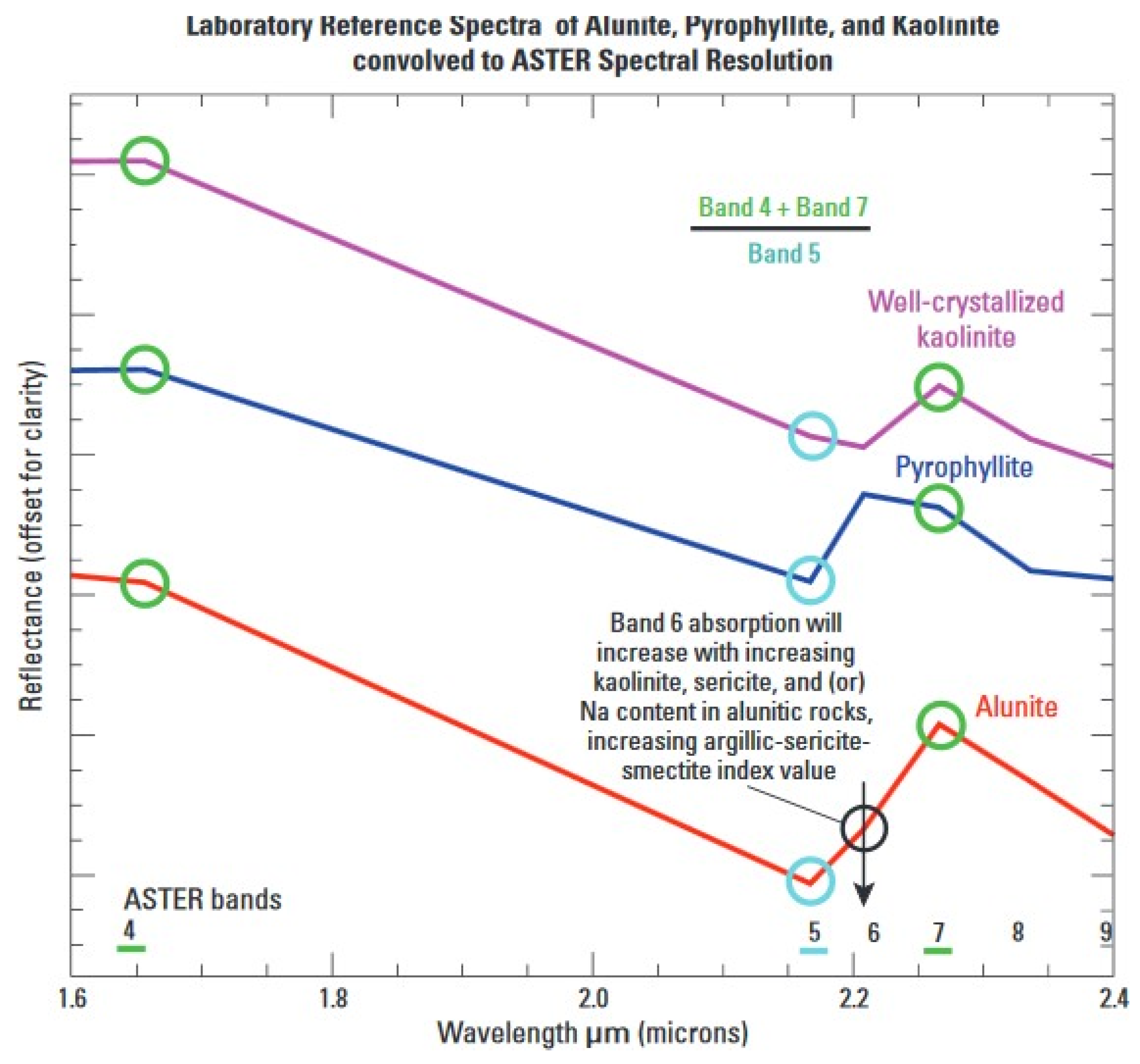
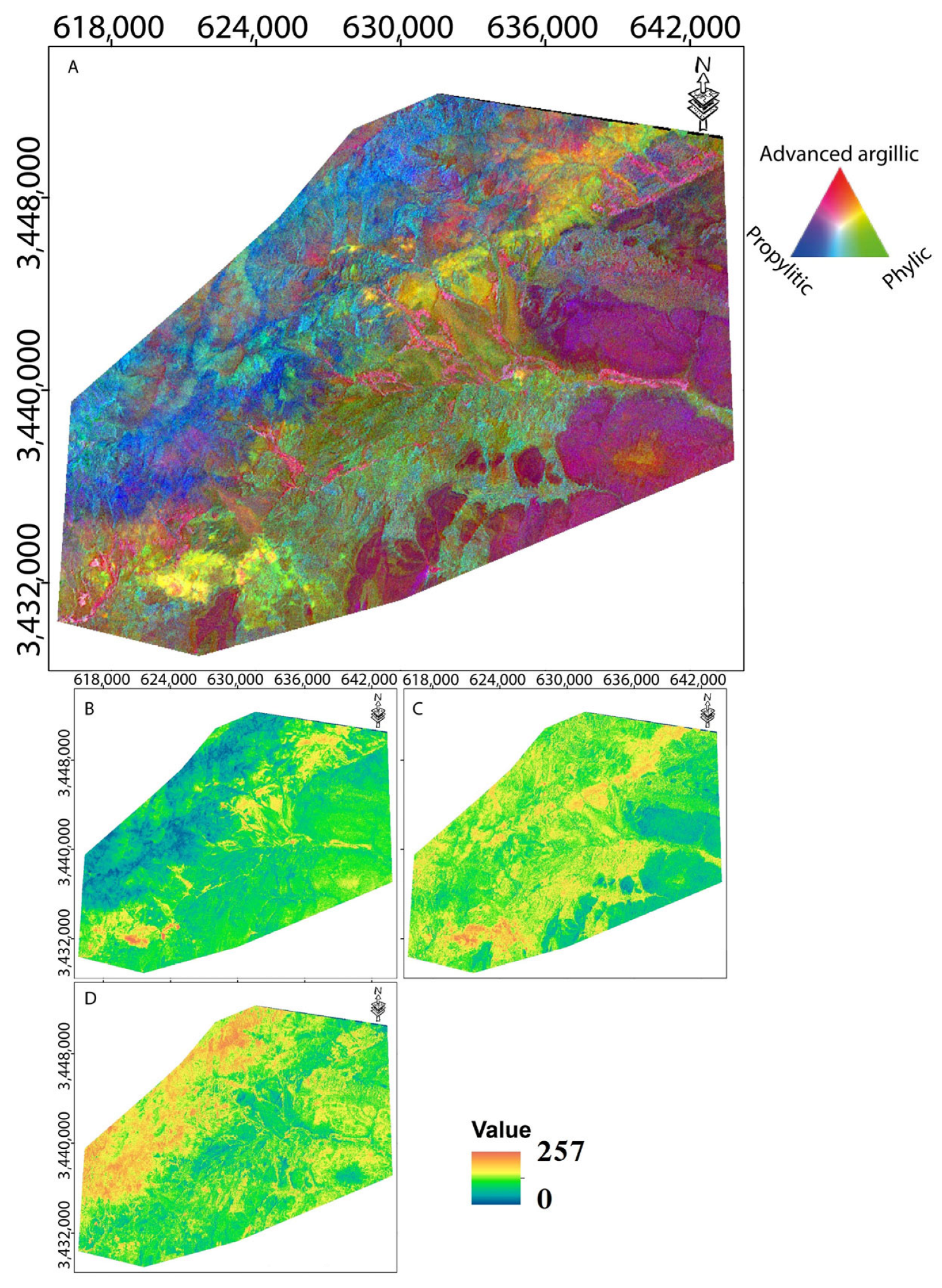

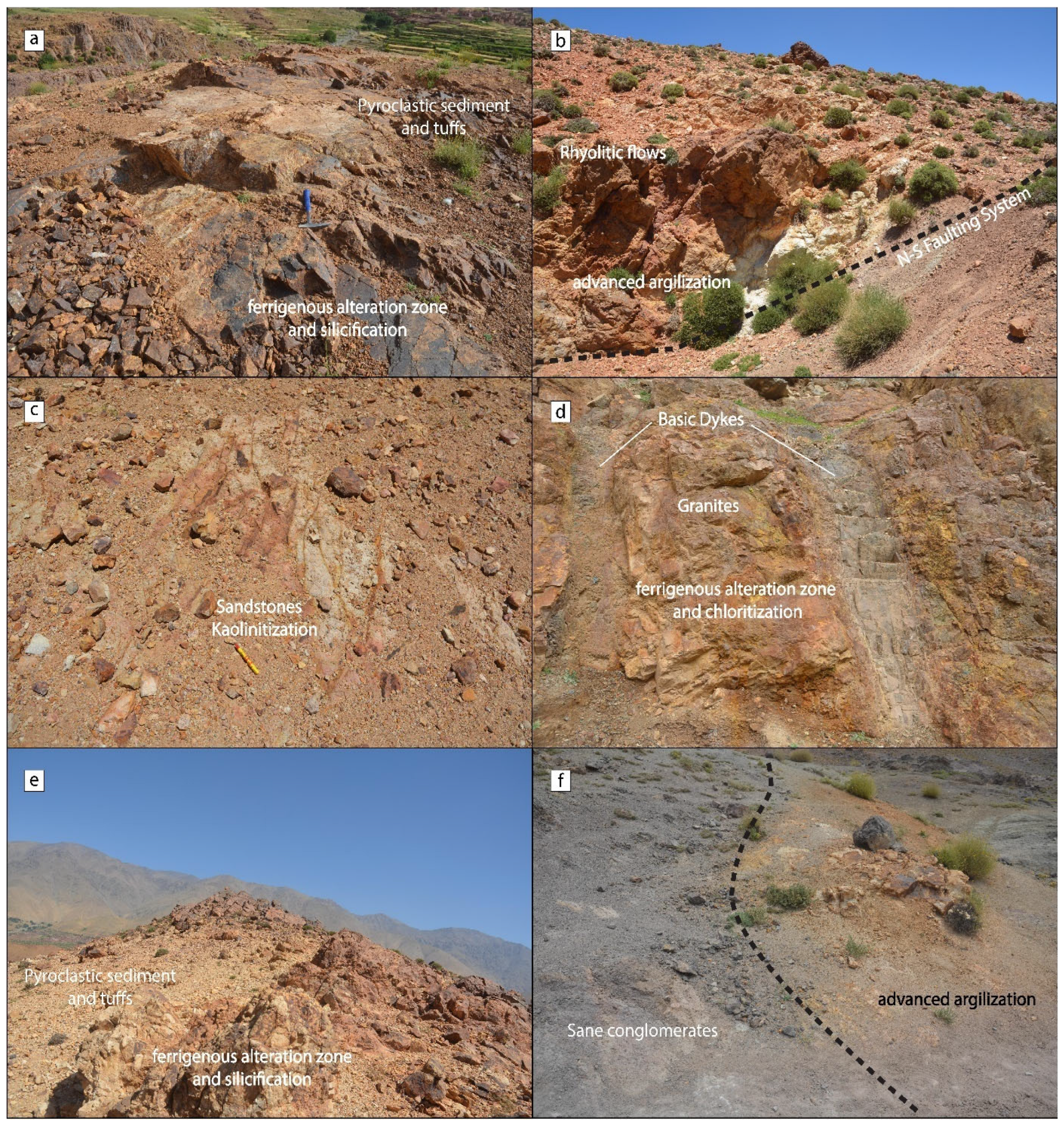

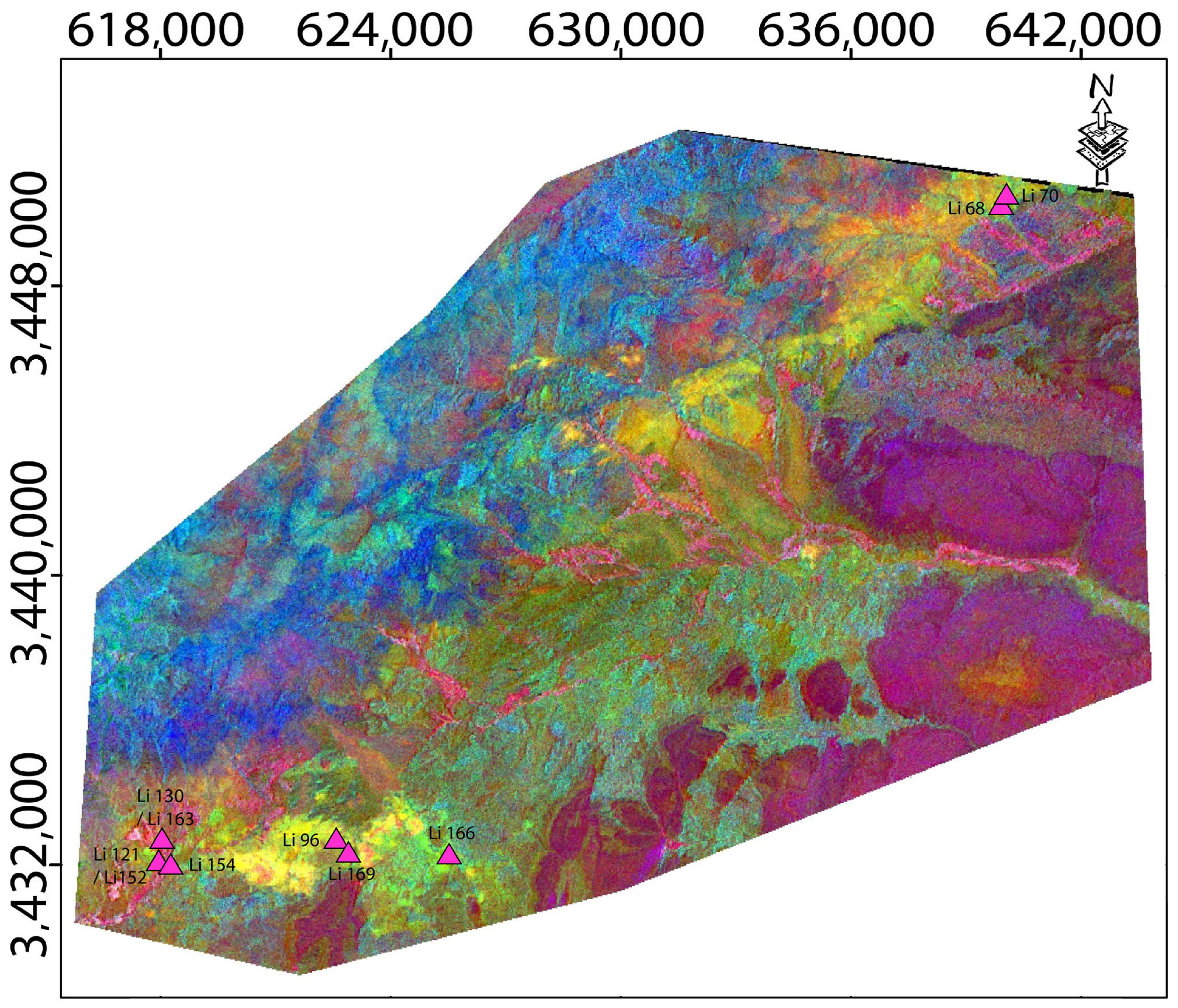
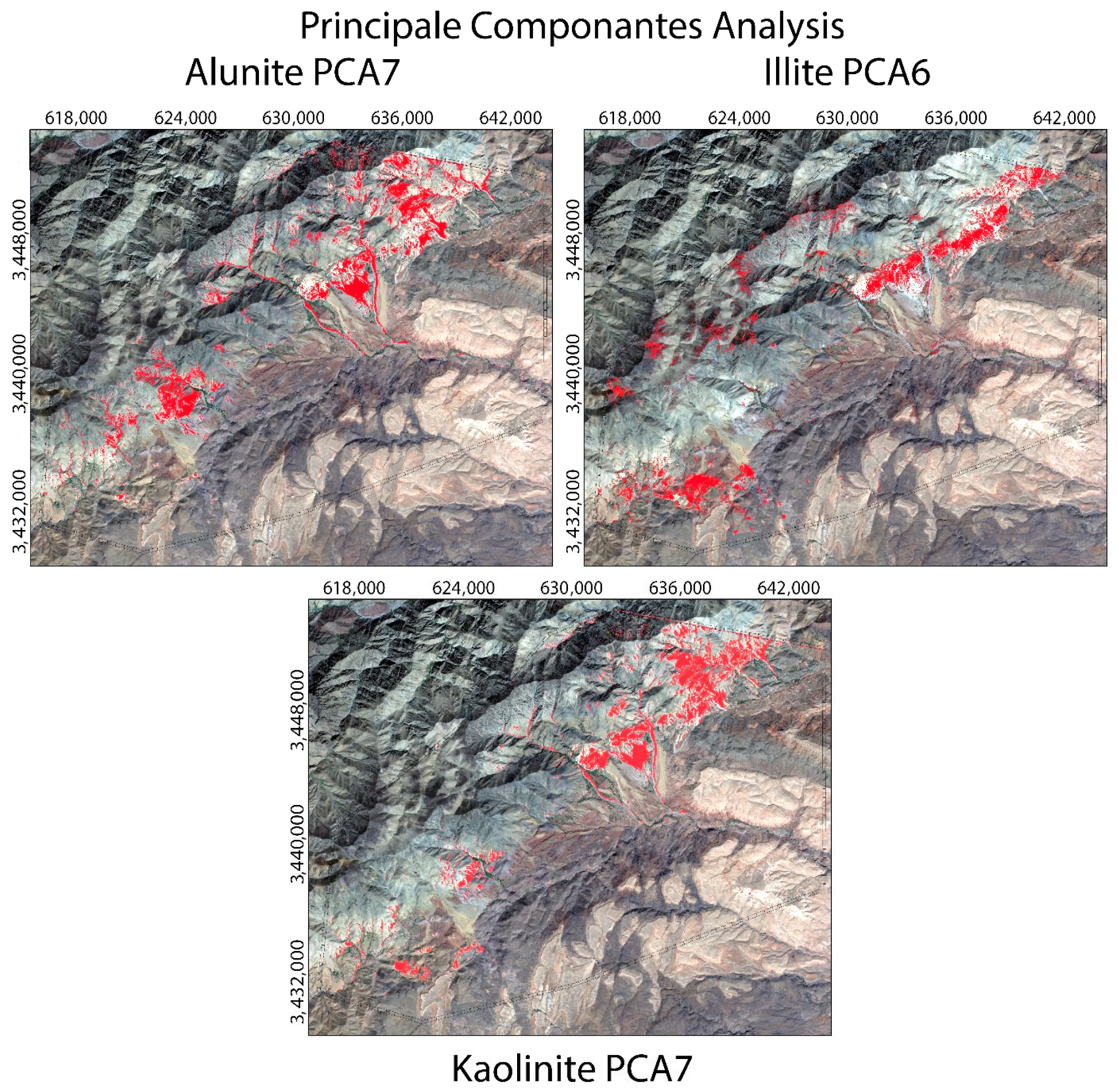
| Quartz (Q) | Albite (A) | Orthose (O) | Anorthite (An) | Muscovite (M) | Illite (I) | Kaolinite (K) | Dickite (D) | Pyrophyllite (P) | Alunite (Al) | |
|---|---|---|---|---|---|---|---|---|---|---|
| Li 68 | X | X | X | X | X | |||||
| Li 70 | X | X | X | X | X | |||||
| Li 96 | X | X | X | X | X | |||||
| Li 121 | X | X | X | X | X | |||||
| Li 130 | X | X | X | X | ||||||
| Li 152 | X | X | X | X | X | |||||
| Li 154 | X | X | X | X | X | X | ||||
| Li 163 | X | X | X | X | ||||||
| Li 169 | X | X | X | X |
| Alteration minerals | |||
|---|---|---|---|
| Alunite | Illite | Kaolinite | |
| Aster bands | 1 | 1 | 1 |
| 3 | 3 | 4 | |
| 5 | 5 | 6 | |
| 7 | 6 | 7 | |
| PCA1 | PCA4 | PCA6 | PCA7 | |
|---|---|---|---|---|
| Band 1 | 0.17164 | 0.89931 | 0.40073 | −0.03449 |
| Band 4 | 0.61626 | 0.21623 | −0.75465 | −0.06300 |
| Band 6 | 0.57611 | −0.32464 | 0.42882 | −0.61549 |
| Band 7 | 0.50879 | −0.19770 | 0.29331 | 0.78487 |
| Kaolinite | Alunite | Illite | |
|---|---|---|---|
| Band 1 | −0.61549 | −0.67762 | 0.73073 |
| Band 2 | 0.78487 | 0.72294 | −0.66351 |
| Layer | 1 | 2 | 3 | 4 | 5 | 6 | 7 | 8 | 9 | 10 | 11 | 12 | 13 | 14 |
|---|---|---|---|---|---|---|---|---|---|---|---|---|---|---|
| 1 | 1 | 0.9928 | 0.98174 | 0.96051 | 0.96683 | 0.96544 | 0.96697 | 0.96719 | 0.97068 | 0.95653 | 0.95627 | 0.95639 | 0.95724 | 0.95721 |
| 2 | 0.9928 | 1 | 0.97891 | 0.96748 | 0.97177 | 0.97184 | 0.97334 | 0.97412 | 0.97509 | 0.93812 | 0.93793 | 0.93774 | 0.93853 | 0.93796 |
| 3 | 0.98174 | 0.97891 | 1 | 0.97239 | 0.97102 | 0.9709 | 0.9706 | 0.96864 | 0.96868 | 0.946 | 0.94706 | 0.94774 | 0.94785 | 0.94707 |
| 4 | 0.96051 | 0.96748 | 0.97239 | 1 | 0.99631 | 0.99581 | 0.99406 | 0.99056 | 0.98644 | 0.92282 | 0.92418 | 0.92487 | 0.92465 | 0.92342 |
| 5 | 0.96683 | 0.97177 | 0.97102 | 0.99631 | 1 | 0.99866 | 0.9967 | 0.99497 | 0.99301 | 0.93278 | 0.93375 | 0.93431 | 0.93444 | 0.93346 |
| 6 | 0.96544 | 0.97184 | 0.9709 | 0.99581 | 0.99866 | 1 | 0.99723 | 0.99638 | 0.99465 | 0.93096 | 0.93184 | 0.93239 | 0.9322 | 0.93109 |
| 7 | 0.96697 | 0.97334 | 0.9706 | 0.99406 | 0.9967 | 0.99723 | 1 | 0.99776 | 0.9944 | 0.93531 | 0.93598 | 0.93647 | 0.93663 | 0.93556 |
| 8 | 0.96719 | 0.97412 | 0.96864 | 0.99056 | 0.99497 | 0.99638 | 0.99776 | 1 | 0.99708 | 0.93396 | 0.93422 | 0.9346 | 0.93485 | 0.9338 |
| 9 | 0.97068 | 0.97509 | 0.96868 | 0.98644 | 0.99301 | 0.99465 | 0.9944 | 0.99708 | 1 | 0.94004 | 0.93981 | 0.94001 | 0.94037 | 0.93971 |
| 10 | 0.95653 | 0.93812 | 0.946 | 0.92282 | 0.93278 | 0.93096 | 0.93531 | 0.93396 | 0.94004 | 1 | 0.99984 | 0.99972 | 0.99949 | 0.99933 |
| 11 | 0.95627 | 0.93793 | 0.94706 | 0.92418 | 0.93375 | 0.93184 | 0.93598 | 0.93422 | 0.93981 | 0.99984 | 1 | 0.99992 | 0.99969 | 0.99947 |
| 12 | 0.95639 | 0.93774 | 0.94774 | 0.92487 | 0.93431 | 0.93239 | 0.93647 | 0.9346 | 0.94001 | 0.99972 | 0.99992 | 1 | 0.99968 | 0.99946 |
| 13 | 0.95724 | 0.93853 | 0.94785 | 0.92465 | 0.93444 | 0.9322 | 0.93663 | 0.93485 | 0.94037 | 0.99949 | 0.99969 | 0.99968 | 1 | 0.99993 |
| 14 | 0.95721 | 0.93796 | 0.94707 | 0.92342 | 0.93346 | 0.93109 | 0.93556 | 0.9338 | 0.93971 | 0.99933 | 0.99947 | 0.99946 | 0.99993 | 1 |
Disclaimer/Publisher’s Note: The statements, opinions and data contained in all publications are solely those of the individual author(s) and contributor(s) and not of MDPI and/or the editor(s). MDPI and/or the editor(s) disclaim responsibility for any injury to people or property resulting from any ideas, methods, instructions or products referred to in the content. |
© 2025 by the authors. Licensee MDPI, Basel, Switzerland. This article is an open access article distributed under the terms and conditions of the Creative Commons Attribution (CC BY) license (https://creativecommons.org/licenses/by/4.0/).
Share and Cite
Lerhris, I.-E.; Admou, H.; Ibouh, H.; El Binna, N. Potential of Remote Sensing for the Analysis of Mineralization in Geological Studies. Geomatics 2025, 5, 40. https://doi.org/10.3390/geomatics5030040
Lerhris I-E, Admou H, Ibouh H, El Binna N. Potential of Remote Sensing for the Analysis of Mineralization in Geological Studies. Geomatics. 2025; 5(3):40. https://doi.org/10.3390/geomatics5030040
Chicago/Turabian StyleLerhris, Ilyass-Essaid, Hassan Admou, Hassan Ibouh, and Noureddine El Binna. 2025. "Potential of Remote Sensing for the Analysis of Mineralization in Geological Studies" Geomatics 5, no. 3: 40. https://doi.org/10.3390/geomatics5030040
APA StyleLerhris, I.-E., Admou, H., Ibouh, H., & El Binna, N. (2025). Potential of Remote Sensing for the Analysis of Mineralization in Geological Studies. Geomatics, 5(3), 40. https://doi.org/10.3390/geomatics5030040







